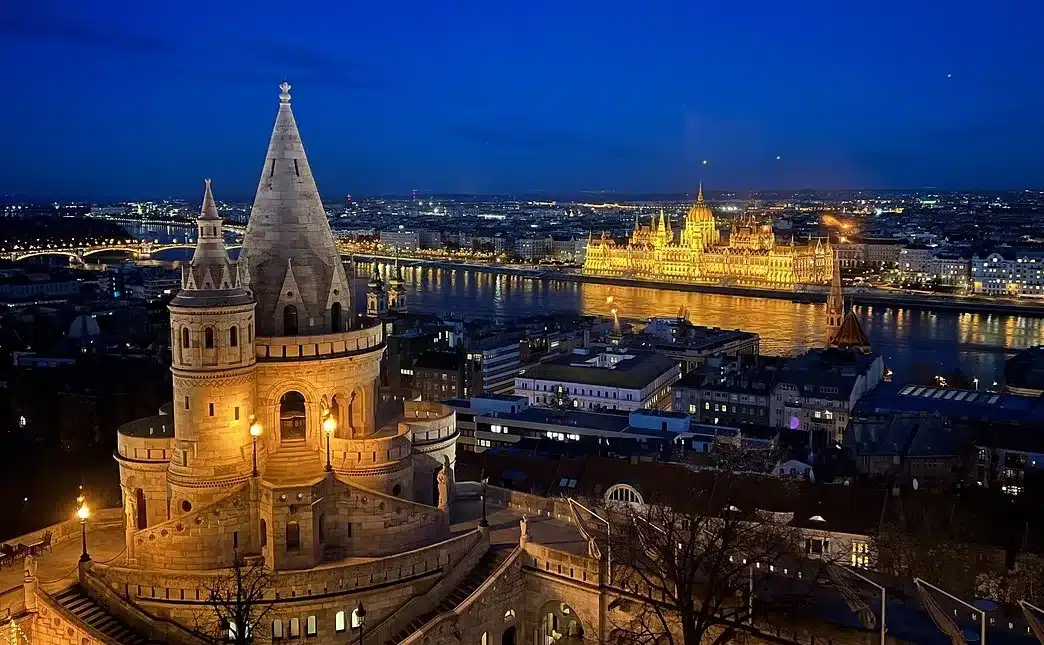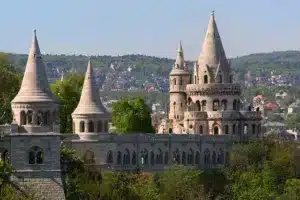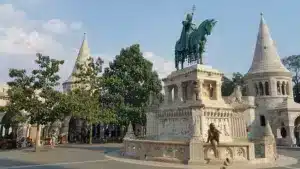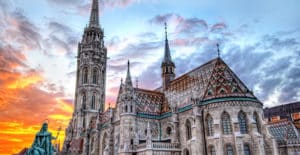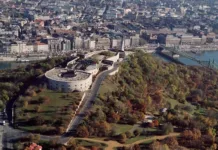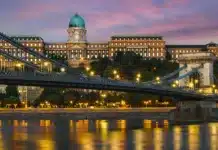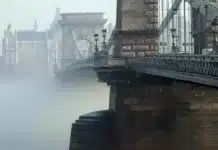Overlooking the hills of Buda, the Fishermen’s Bastion of Budapest offers a majestic view of the Hungarian capital and the mighty Danube. This architectural gem features elegant towers and stepped terraces reflecting both its medieval past and its neo-Romanesque splendour.
The Fishermen’s Bastion dominates the Buda Castle district of Budapest. Situated next to the emblematic Matthias Church, this monument has offered the best view in Budapest for over a century.
History of the Fishermen’s Bastion in Budapest

The Fishermen’s Bastion, known as the ‘Halászbástya‘ in Hungarian, is a building that embodies the spirit of Budapest. Although its elegant towers and white walls evoke medieval architecture, the bastion is in fact a much more recent addition to the city.
The bastion was built between 1895 and 1902 in a neo-Romanesque and neo-Gothic style, designed by Hungarian architect Frigyes Schulek. It was built to commemorate the millennium of the founding of Hungary. Its name comes from the fact that it was built on the site where medieval fishermen from Budapest used to stand to defend the city. However, contrary to its name, the bastion was never used for military purposes.
Elegant neo-Gothic architecture on the banks of the Danube

The Fishermen’s Bastion combines the romanticism of the Romanesque Revival style with the grandeur of the Gothic Revival!
The Bastion is made up of seven towers of different sizes, each representing one of the seven Magyar tribes that founded Hungary in the 9th century. The towers are linked by balconies and staircases, creating a picturesque, panoramic structure.
Arches and columns are characteristic elements of neo-Romanesque and neo-Gothic architecture. They are used decoratively to accentuate different parts of the bastion.
The façade of the Fishermen’s Bastion is adorned with numerous sculptural details, such as floral motifs, mythological figures and historical symbols. These sculptures add richness and complexity to the overall architecture.
Arched windows are another typical feature of neo-Gothic architecture. They are often decorated with geometric motifs and coloured stained glass, adding a touch of colour and light to the structure.
Finally, the Fishermen’s Bastion was built in white stone, giving it a luminous, elegant appearance. Stone is also used for the decorative details and sculptures, adding texture and depth to the structure as a whole.
The statue of St Stephen

The statue in front of the Fishermen’s Bastion in Budapest is of Saint Stephen, the first Christian king of Hungary and founder of the Hungarian state. It was erected in 1906 by the Hungarian sculptor Alajos Stróbl.
This imposing equestrian statue is an emblematic feature of the Fishermen’s Bastion, adding a touch of grandeur and symbolism to this historic site. It pays tribute to the importance of Saint Stephen in the history and culture of Hungary.
Matthias Church

Situated in front of the bastion, the Matthias Church in Budapest, also known as the Church of Our Lady of the Assumption in ‘Budavár’, is a gothic marvel. Find out more about this church in our dedicated article on this link.
Address: Matthias Church, Szentháromság tér 2, 1st district, Buda – map – website.
Breathtaking views from the Fishermen’s Bastion
From the top of its stepped terraces, visitors can admire some of Budapest’s most iconic landmarks, such as the Hungarian Parliament, the Chain Bridge and the Bastion itself. Whether at sunrise or dusk, the panorama from the Fishermen’s Bastion is breathtaking, offering a unique perspective on the splendour of the Hungarian capital. Discover it with this beautiful video above.
Visit the Fishermen’s Bastion and practical advice:
Entrance fees to the Fishermen’s Bastion in Budapest are flexible, depending on which part of the Fishermen’s Bastion you wish to visit. What’s more, on certain days and at certain times, visits to the towers and terraces of the Fishermen’s Bastion are completely free of charge.
Most of the balconies and the seven towers – which span 140 metres – are free to enter, while the upper towers or turrets are subject to an entrance fee of around €3.4 (€1.7 for students and children under 14, €1.5 for pensioners).
Here are the times and dates when you can visit the entire Fishermen’s Bastion free of charge:
Free admission in the morning before 9.00am.
Free entry in the evening after 9pm (between 1 June and 30 September), and in the evening after 7pm (between 1 October and 31 May).
Free admission on 15 March, Hungary’s bank holidays.
Free entry on 20 August, Hungarian National Day (fireworks at 9pm).
Free entry on 23 October, National Day.
Free admission all day between 24 December and 2 January.


